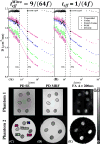Validation of surface-to-volume ratio measurements derived from oscillating gradient spin echo on a clinical scanner using anisotropic fiber phantoms
- PMID: 28328013
- PMCID: PMC5501714
- DOI: 10.1002/nbm.3708
Validation of surface-to-volume ratio measurements derived from oscillating gradient spin echo on a clinical scanner using anisotropic fiber phantoms
Abstract
A diffusion measurement in the short-time surface-to-volume ratio (S/V) limit (Mitra et al., Phys Rev Lett. 1992;68:3555) can disentangle the free diffusion coefficient from geometric restrictions to diffusion. Biophysical parameters, such as the S/V of tissue membranes, can be used to estimate microscopic length scales non-invasively. However, due to gradient strength limitations on clinical MRI scanners, pulsed gradient spin echo (PGSE) measurements are impractical for probing the S/V limit. To achieve this limit on clinical systems, an oscillating gradient spin echo (OGSE) sequence was developed. Two phantoms containing 10 fiber bundles, each consisting of impermeable aligned fibers with different packing densities, were constructed to achieve a range of S/V values. The frequency-dependent diffusion coefficient, D(ω), was measured in each fiber bundle using OGSE with different gradient waveforms (cosine, stretched cosine, and trapezoidal), while D(t) was measured from PGSE and stimulated-echo measurements. The S/V values derived from the universal high-frequency behavior of D(ω) were compared against those derived from quantitative proton density measurements using single spin echo (SE) with varying echo times, and from magnetic resonance fingerprinting (MRF). S/V estimates derived from different OGSE waveforms were similar and demonstrated excellent correlation with both SE- and MRF-derived S/V measures (ρ ≥ 0.99). Furthermore, there was a smoother transition between OGSE frequency f and PGSE diffusion time when using teffS/V=9/64f, rather than the commonly used teff = 1/(4f), validating the specific frequency/diffusion time conversion for this regime. Our well-characterized fiber phantom can be used for the calibration of OGSE and diffusion modeling techniques, as the S/V ratio can be measured independently using other MR modalities. Moreover, our calibration experiment offers an exciting perspective of mapping tissue S/V on clinical systems.
Keywords: OGSE diffusion; STEAM diffusion; anisotropic diffusion phantom; magnetic resonance fingerprinting; surface to volume ratio.
Copyright © 2017 John Wiley & Sons, Ltd.
Figures





Similar articles
-
Surface-to-volume ratio mapping of tumor microstructure using oscillating gradient diffusion weighted imaging.Magn Reson Med. 2016 Jul;76(1):237-47. doi: 10.1002/mrm.25865. Epub 2015 Jul 24. Magn Reson Med. 2016. PMID: 26207354 Free PMC article.
-
Changes in the ADC of diffusion-weighted MRI with the oscillating gradient spin-echo (OGSE) sequence due to differences in substrate viscosities.Jpn J Radiol. 2018 Jul;36(7):415-420. doi: 10.1007/s11604-018-0737-0. Epub 2018 Apr 26. Jpn J Radiol. 2018. PMID: 29700795
-
Acquisition of pure-phase diffusion spectra using oscillating-gradient spin echo.J Magn Reson. 2005 Oct;176(2):151-9. doi: 10.1016/j.jmr.2005.06.001. J Magn Reson. 2005. PMID: 16009585
-
Measuring restriction sizes using diffusion weighted magnetic resonance imaging: a review.Magn Reson Insights. 2013 May 19;6:59-64. doi: 10.4137/MRI.S11149. eCollection 2013. Magn Reson Insights. 2013. PMID: 25114548 Free PMC article. Review.
-
Effects of biological tissue structural anisotropy and anisotropy of magnetic susceptibility on the gradient echo MRI signal phase: theoretical background.NMR Biomed. 2017 Apr;30(4):10.1002/nbm.3655. doi: 10.1002/nbm.3655. Epub 2016 Nov 11. NMR Biomed. 2017. PMID: 27862452 Free PMC article. Review.
Cited by
-
Physical and numerical phantoms for the validation of brain microstructural MRI: A cookbook.Neuroimage. 2018 Nov 15;182:39-61. doi: 10.1016/j.neuroimage.2018.06.046. Epub 2018 Jun 18. Neuroimage. 2018. PMID: 29920376 Free PMC article. Review.
-
Is Apparent Diffusion Coefficient Established as an Imaging Biomarker for Stereotactic Body Radiation Therapy Assessment in Hepatocellular Carcinoma?Cancer J. 2023 Jul-Aug 01;29(4):238-242. doi: 10.1097/PPO.0000000000000668. Cancer J. 2023. PMID: 37471615 Free PMC article. Review.
-
Probing neural tissues at small scales: Recent progress of oscillating gradient spin echo (OGSE) neuroimaging in humans.J Neurosci Methods. 2021 Feb 1;349:109024. doi: 10.1016/j.jneumeth.2020.109024. Epub 2020 Dec 14. J Neurosci Methods. 2021. PMID: 33333089 Free PMC article.
-
Quantifying brain microstructure with diffusion MRI: Theory and parameter estimation.NMR Biomed. 2019 Apr;32(4):e3998. doi: 10.1002/nbm.3998. Epub 2018 Oct 15. NMR Biomed. 2019. PMID: 30321478 Free PMC article. Review.
-
Frequency-dependent diffusion kurtosis imaging in the human brain using an oscillating gradient spin echo sequence and a high-performance head-only gradient.Neuroimage. 2023 Oct 1;279:120328. doi: 10.1016/j.neuroimage.2023.120328. Epub 2023 Aug 14. Neuroimage. 2023. PMID: 37586445 Free PMC article.
References
-
- Bihan DL, Breton E, Lallemand D, Aubin ML, Vignaud J, Laval-Jeantet M. Separation of diffusion and perfusion in intravoxel incoherent motion MR imaging. Radiology. 1988;168(2):497–505. - PubMed
-
- Hagmann P, Jonasson L, Maeder P, Thiran J-P, Wedeen VJ, Meuli R. Understanding Diffusion MR Imaging Techniques: From Scalar Diffusion-weighted Imaging to Diffusion Tensor Imaging and Beyond. Radiographics: a review publication of the Radiological Society of North America, Inc. 2006;26(suppl_1):S205–S223. - PubMed
-
- Srinivasan A, Goyal M, Azri FA, Lum C. State-of-the-Art Imaging of Acute Stroke. Radiographics: a review publication of the Radiological Society of North America, Inc. 2006;26(suppl_1):S75–S95. - PubMed
-
- Padhani AR, Liu G, Mu-Koh D, Chenevert TL, Thoeny HC, Takahara T, Dzik-Jurasz A, Ross BD, Van Cauteren M, Collins D, Hammoud DA, Rustin GJS, Taouli B, Choyke PL. Diffusion-Weighted Magnetic Resonance Imaging as a Cancer Biomarker: Consensus and Recommendations. Neoplasia. 2009;11(2):102–125. - PMC - PubMed
MeSH terms
Substances
Grants and funding
LinkOut - more resources
Full Text Sources
Other Literature Sources
Miscellaneous

